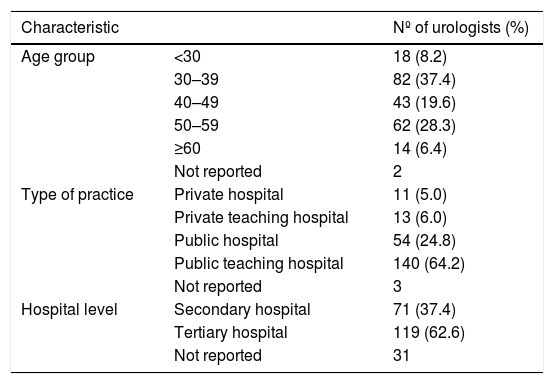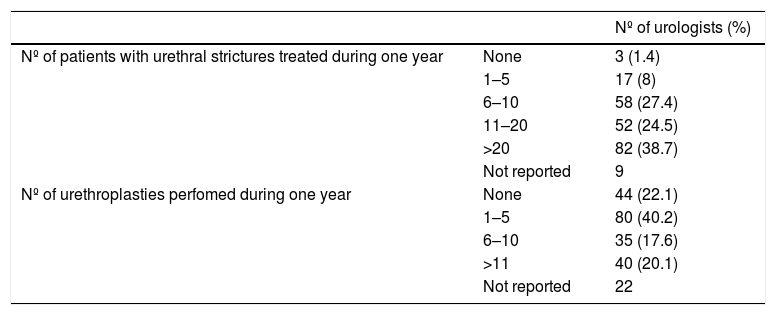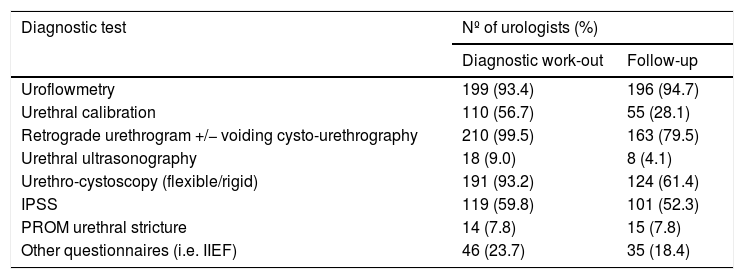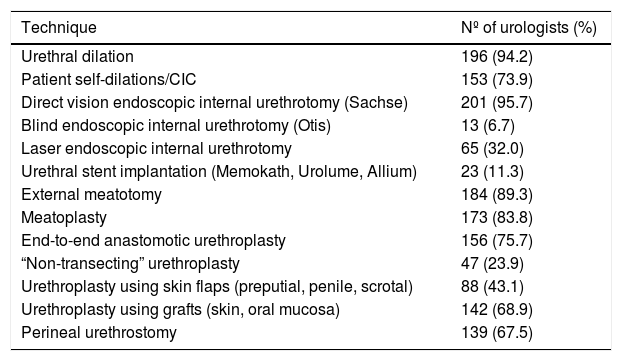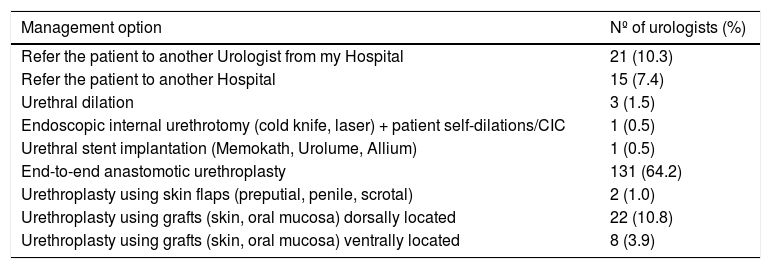Assessment of urethral stricture (US) management seems important to evaluate the quality of attention and plan educational interventions. We aim to investigate the practice patterns on diagnostic and therapeutic approaches to adult male anterior US among urologists in Spain.
Materials and methods23-question on-line survey conducted among all members of AEU (Spanish Urological Association). Demography data and practices on evaluation and treatment of US were included. 1737 invitation letters sent by email, with 21.7% response rate. Data were prospectively collected during 2016. Descriptive analysis and univariate comparisons conducted using X2 test. Statistical significance considered when P ≤ 0.05.
ResultsResponders were mainly from Tertiary and Teaching University Hospitals. 63.2% treated ≥10 patients/year with US. Retrograde urethrogram (RUG) was the commonest diagnostic tool followed by uroflowmetry (UF), and internal urethrotomy under direct vision (DVIU) the most frequent treatment. 84.4% limited DVIU for US ≤ 1.5 cm. 62.3% performed ≤5 urethroplasties/year. Anastomotic urethroplasties were performed by 75.7% and graft repairs by 68.9%. Dorsal grafting was preferred rather than ventral. Non-transecting techniques were used by 23.9%. UF was the most common follow-up tool. 88.4% felt that referral units were required. Tertiary hospitals used Patient Reported Outcome Measure (PROM) questionnaires more frequently than secondary centres. High-volume urologists were more likely to use non-transecting techniques and to choose urethroplasty as first choice procedure.
ConclusionsMale anterior US in Spain are treated by many urologists, mainly using endoscopic procedures. RUG is preferred for diagnosis, and UF for follow-up. A high percentage of urologists perform urethroplasties, mainly anastomotic repairs, but in low volume.
Conocer el manejo de la estenosis uretral (EU) es importante para evaluar la calidad asistencial y planificar acciones formativas. Planteamos investigar prácticas diagnósticas y terapéuticas de los urólogos en España para el manejo de EU anterior del varón adulto.
Materiales y métodosRealizamos un cuestionario on-line de 23 preguntas entre los miembros de la AEU (Asociación Española de Urología). Evaluamos datos demográficos y referentes a la evaluación y tratamiento de EU. 1737 invitaciones enviadas por correo electrónico, con 21.7% de respuestas. Recogida prospectiva durante 2016. Análisis descriptivo y comparaciones univariantes empleando test de X2. Significación estadística cuando P ≤ 0.05.
ResultadosParticiparon principalmente urólogos de hospitales terciarios y universitarios. 63.2% tratan ≥10 pacientes/ año con EU. Uretrografía retrógrada (UGR) es la prueba diagnóstica más empleada, seguida de uroflujometría (UF). Uretrotomía interna bajo visión directa (UIVD) es el tratamiento más común. 84.4% limitan la UIVD a EU ≤ 1.5 cm. 62.3% realizan ≤5 uretroplastias/año. 75.7% hacen uretroplastias anastomóticas y 68.9% emplean injertos. Existe preferencia por injertar dorsalmente. 23.9% emplea técnicasnon-transecting. UF es la prueba preferida para seguimiento. 88.4% refieren que son necesarias unidades de referencia. En centros terciarios realizan cuestionarios PROM (Patient Reported Outcome Measure) más frecuentemente que en secundarios. Urólogos con alto volumen de cirugías usan más comúnmente técnicas non-transecting y eligen la uretroplastia como opción de primera línea.
ConclusionesLa EU anterior del varón en España es tratada por gran cantidad de urólogos, principalmente mediante endoscopia. La UGR se prefiere para diagnóstico y UF para seguimiento. Un elevado porcentaje de urólogos realiza uretroplastia, mayoritariamente anastomótica, pero con bajo número de casos.
Artículo
Comprando el artículo el PDF del mismo podrá ser descargado
Precio 19,34 €
Comprar ahora






